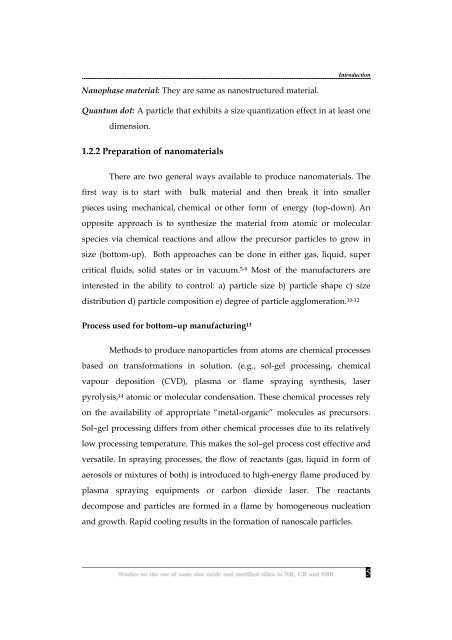Studies on the use of nano zinc oxide and modified silica in NR, CR ...
Studies on the use of nano zinc oxide and modified silica in NR, CR ...
Studies on the use of nano zinc oxide and modified silica in NR, CR ...
You also want an ePaper? Increase the reach of your titles
YUMPU automatically turns print PDFs into web optimized ePapers that Google loves.
Nanophase material: They are same as <strong>nano</strong>structured material.<br />
Introducti<strong>on</strong><br />
Quantum dot: A particle that exhibits a size quantizati<strong>on</strong> effect <strong>in</strong> at least <strong>on</strong>e<br />
dimensi<strong>on</strong>.<br />
1.2.2 Preparati<strong>on</strong> <strong>of</strong> <strong>nano</strong>materials<br />
There are two general ways available to produce <strong>nano</strong>materials. The<br />
first way is to start with bulk material <strong>and</strong> <strong>the</strong>n break it <strong>in</strong>to smaller<br />
pieces us<strong>in</strong>g mechanical, chemical or o<strong>the</strong>r form <strong>of</strong> energy (top-down). An<br />
opposite approach is to syn<strong>the</strong>size <strong>the</strong> material from atomic or molecular<br />
species via chemical reacti<strong>on</strong>s <strong>and</strong> allow <strong>the</strong> precursor particles to grow <strong>in</strong><br />
size (bottom-up). Both approaches can be d<strong>on</strong>e <strong>in</strong> ei<strong>the</strong>r gas, liquid, super<br />
critical fluids, solid states or <strong>in</strong> vacuum. 5-9 Most <strong>of</strong> <strong>the</strong> manufacturers are<br />
<strong>in</strong>terested <strong>in</strong> <strong>the</strong> ability to c<strong>on</strong>trol: a) particle size b) particle shape c) size<br />
distributi<strong>on</strong> d) particle compositi<strong>on</strong> e) degree <strong>of</strong> particle agglomerati<strong>on</strong>. 10-12<br />
Process <strong>use</strong>d for bottom–up manufactur<strong>in</strong>g 13<br />
Methods to produce <strong>nano</strong>particles from atoms are chemical processes<br />
based <strong>on</strong> transformati<strong>on</strong>s <strong>in</strong> soluti<strong>on</strong>. (e.g., sol-gel process<strong>in</strong>g, chemical<br />
vapour depositi<strong>on</strong> (CVD), plasma or flame spray<strong>in</strong>g syn<strong>the</strong>sis, laser<br />
pyrolysis, 14 atomic or molecular c<strong>on</strong>densati<strong>on</strong>. These chemical processes rely<br />
<strong>on</strong> <strong>the</strong> availability <strong>of</strong> appropriate “metal-organic” molecules as precursors.<br />
Sol–gel process<strong>in</strong>g differs from o<strong>the</strong>r chemical processes due to its relatively<br />
low process<strong>in</strong>g temperature. This makes <strong>the</strong> sol–gel process cost effective <strong>and</strong><br />
versatile. In spray<strong>in</strong>g processes, <strong>the</strong> flow <strong>of</strong> reactants (gas, liquid <strong>in</strong> form <strong>of</strong><br />
aerosols or mixtures <strong>of</strong> both) is <strong>in</strong>troduced to high-energy flame produced by<br />
plasma spray<strong>in</strong>g equipments or carb<strong>on</strong> di<strong>oxide</strong> laser. The reactants<br />
decompose <strong>and</strong> particles are formed <strong>in</strong> a flame by homogeneous nucleati<strong>on</strong><br />
<strong>and</strong> growth. Rapid cool<strong>in</strong>g results <strong>in</strong> <strong>the</strong> formati<strong>on</strong> <strong>of</strong> <strong>nano</strong>scale particles.<br />
5

















